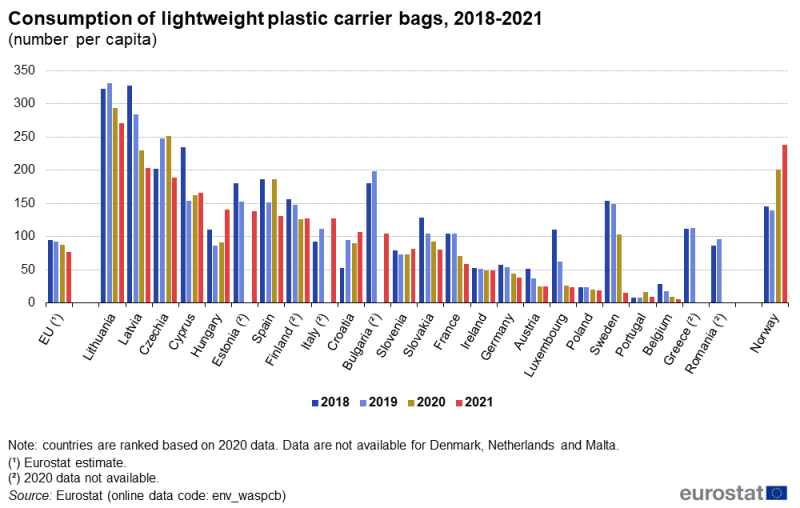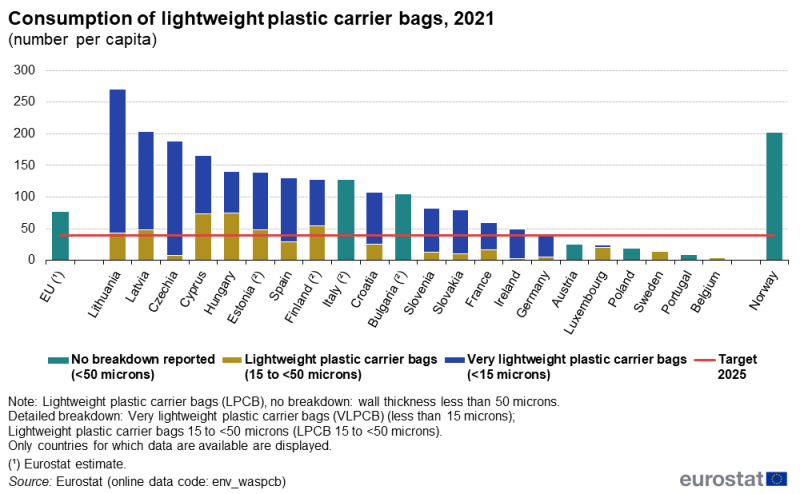Consumption of plastic carrier bags - estimates
Data from: October 2023
Planned update: October 2024
Highlights
Lightweight plastic carrier bags (LPCBs) consumption over time in the EU and Norway
This article shows statistics on consumption of lightweight plastic carrier bags (LPCBs) in the European Union (EU) Member States and the EFTA country Norway. Official reporting on LPCBs was first implemented for the reference year 2018 and consumption data for the period 2018–2021 is now available for most EU Member States. Information and data are based on Directive 2015/720 (The Plastic Bags Directive), which lays down consumption reduction requirements. The Plastic Bags Directive aims to reduce consumption of LPCBs in order to combat littering, change consumer behaviour and promote waste prevention.
Full article
Data collection
Countries commonly collect their LPCB consumption data from either producers and importers of carrier bags or from retailers. Producers and importers reporting is commonly made to either national packaging registries, organisations managing extended producer responsibility (EPR) schemes, or directly to government departments such as environmental and financial ministries. Retailer reporting is commonly made either directly to government departments or via national registries. There are also multiple instances of countries conducting surveys of retailers, either as a primary data collection method or to fill in data gaps.
Lightweight plastic carrier bag consumption
The EU inhabitants consumed 94 LPCBs per capita in 2018, 93 in 2019, 87 in 2020, and 77 in 2021. In 2021, reported consumption for individual countries ranged from 5 LPCBs per capita in Belgium to 271 in Lithuania, with the latter driven by high consumption of very lightweight plastic carrier bags (i.e. bags with a wall thickness below 15 microns).
As all Member States now have consumption reduction measures in place as required by the Plastic Bags Directive, the wide range seen in per capita consumption is primarily attributable to differences in the effectiveness of these measures, depending on a variety of economic, social, and policy factors.
Another reason is that, as some countries introduced consumption reduction measures in response to Article 4(1a) during the 2018–2021 period, the consumption data reflects the fact that some countries have had measures in place longer than others, allowing more time for consumption patterns to change.
A third potential explanation of the wide range in reported consumption is the variety of different collection methodologies used by different Member States. It cannot be ruled out that some extremities in the consumption range are attributable to methodological issues resulting in inaccurate data. Overall, data quality has been improving each year and is expected to improve further.

(number per capita)
Source: Eurostat (env_waspcb)
Very lightweight plastic carrier bag consumption
While Member States are required to report consumption data on the total number of LPCBs consumed in their territory, they may also provide voluntary disaggregated data on the consumption of very lightweight plastic carrier bags (VLPCBs), which are bags with a wall thickness of less than 15 microns, and the remaining LPCBs (of 15<50 microns wall thickness).
In 2021, among the EU Member States that provided data on VLPCB consumption, the proportion of total LPCB consumption that was VLPCB consumption ranged from 95.6 % in Czechia to 13.3 % in Sweden. Among these countries, VLPCBs accounted for 77.7 % of LPCB consumption overall. Per capita consumption of VLPCBs for these countries is shown below.

(number per capita)
Source: Eurostat (env_waspcb)
Note that countries may also voluntarily provide consumption data for plastic carrier bags with a wall thickness greater than 50 microns, which are not included under the definition of LPCBs. In 2021, 10 countries provided data on consumption of these thicker plastic carrier bags.
Conclusions
- The EU Member States reporting LPCB consumption data for 2018, 2019, 2020, and 2021 together achieved an overall reduction in the total number of LPCB consumed of 31 % from 2018 to 2021.
- The EU Member States that voluntarily reported disaggregated data for all four years together achieved an overall reduction of 57 % in 15<50 micron LPCB consumption from 2018 to 2021, while their consumption of VLPCBs decreased by 12.7 %. Overall, among these countries, VLPCBs represented 63.2 % of total LPCB consumption in 2018, 71.4 % in 2019, 73.1 % in 2020, and 77.8 % in 2021. 2021 is the first year that VLPCB consumption has decreased overall among the EU countries reporting voluntary disaggregated data for all reporting years, as previously VLPCB consumption had been increasing slightly each year (likely due to consumers substituting VLPCBs for 15<50 micron LPCBs to some extent).
Source data for tables and graphs
Data sources
The lightweight plastic carrier bag data are reported by the EU Member States as laid down in Commission Implementing Decision (EU) 2018/896. The reported data are usually available in the Eurostat database on waste approximately 21 months after the end of the reference year.
Context
Directive 2015/720 on reducing the consumption of lightweight plastic carrier bags is an amendment to Directive 94/62/EC on packaging and packaging waste (Packaging Waste Directive). It was the first EU directive requiring Member States to take measures to achieve a sustained reduction in the consumption of a specified product, and aims to reduce consumption of lightweight plastic carrier bags in order to combat littering, change consumer behaviour and promote waste prevention. It requires Member States to either adopt measures to ensure consumption does not exceed specified target levels as set in the Directive, or to prohibit the provision of lightweight plastic carrier bags free of charge at the point of sale of goods and services. Member States may also implement a combination of these measures.
Commission Implementing Decision (EU) 2018/896 lays down the methodology for the calculation of the annual consumption of lightweight plastic carrier bags.
Definitions
- Plastic carrier bags (PCBs) are defined as carrier bags, with or without handles, made of plastic, which are supplied to consumers at the point of sale of goods or products.
- Lightweight plastic carrier bags are defined as plastic carrier bags with a wall thickness below 50 microns.
- Very lightweight plastic carrier bags are defined as plastic carrier bags with a wall thickness below 15 microns that are required for hygiene purposes or provided as primary packaging for loose food when this helps to prevent food wastage.
Direct access to
See also
- Environment statistics introduced
- Waste statistics
- End-of-life vehicle statistics
- Food waste and food waste prevention - estimates
- Municipal waste statistics
- Packaging waste statistics
- Recycling – secondary material price indicator
- Waste management indicators
- Waste shipment statistics
- Waste statistics - electrical and electronic equipment
- Waste statistics - recycling of batteries and accumulators
Dedicated section
Publications
- All publications on waste issued by Eurostat.
- Energy, transport and environment indicators — 2020 edition
Methodology
- Consumption of lightweight plastic carrier bags by their wall thickness (ESMS metadata file — env_waspcb_esms)
- Eurostat - Guidance for reporting annual consumption of lightweight plastic carrier bags according to Commission Implementing Decision (EU) 2018/896 (version of 09 May 2022)
- Summary of options taken by Member States in accordance with Article 4(1a) of the Packaging and Packaging Waste Directive
- Country-specific notes on Lightweight Plastic Carrier Bags (version of 07 November 2023)
Legislation
- Directive 94/62/EC on packaging and packaging waste (PPW Directive)
- Directive 2015/720 as regards reducing the consumption of lightweight plastic carrier bags, amending Directive 94/62/EC (The Plastic Bags Directive)
- Commission Implementing Decision (EU) 2018/896 laying down the methodology for the calculation of the annual consumption of lightweight plastic carrier bags
- Commission Implementing Decision (EU) 2019/665 establishing the formats relating to the database system pursuant to Directive 94/62/EC on packaging and packaging waste
External links